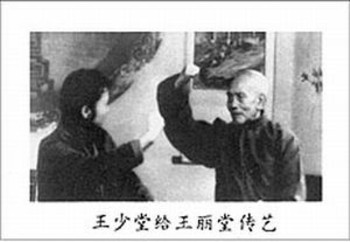Masters and Disciples (14)

Transmission of the art and training of disciples
Professional storytelling is a highly specialized art and the artists have to go through many years of training from childhood or early youth. The traditional transmission of the storytellers’ art from generation to generation took place in the family. It was called ’oral transmission and teaching from the heart’ kou chuan xin shou. Usually storytelling was a family enterprise and the master would teach one or several of his own sons or male relatives (after the 1930s also daughters) to continue his art, but it was also a common practice to accept disciples from outside the family.
The children were trained from the early age of five or six, and sometimes appeared in public before the age of ten. Famous masters were called upon to take in disciples from outside, and at times such a master might by himself suggest that a younger promising storyteller should become his disciple. But more often storytellers were reluctant to take in children from other families, either because they feared to lose the family 'fortune', or simply because it was a hard job to train a new disciple, and the master would be responsible for the child.
If the disciple was from another family, a contract was set up between the master and the parents of the child. There was an initiation ceremony with gifts and a meal served to the master. The legalization of the relationship between master and disciple, the ceremony accompanying the situations of instituting and dissolving such relationship was regarded as important. The naming of the regular students is also of particular importance, since the hereditary line of a certain school of storytelling, the identity of the ‘school and branch’ menpai, is based on the masters’ accept of his student by ‘bestowing him an artist’s name’ ciming. The lineage is shown by a common component in the names of all the storytellers of the same line, i.e. the component ‘tang’ found in the names of storytellers of the Wang school, ‘hua’ with the Kang School, ‘liang’ with the Wu School and ‘zhang’ with the Dai School. The name system is, however, not always that simple, as a glance at the table of storyteller’s hereditary lines will show.